This weekend saw a top-of-the-table WSL clash between Arsenal and Manchester City.
Manchester City came into this game in fantastic form, leading the league, having only dropped points against reigning WSL champions Chelsea in a 1-1 draw where City went down to nine players for the last fifteen minutes.
In stark contrast, Arsenal come into this game in underwhelming form, having been knocked out of the Champions League by Paris FC, losing on opening weekend against Liverpool, a 2-2 draw against Manchester United and requiring two injury-time goals to win 2-1 against bottom-of-the-table Aston Villa.
In this tactical analysis, we will take a look at how Arsenal’s tactics were set up and were able to nullify the Manchester City threat with an analysis of some signs of significant positives to build on for Arsenal moving forward.
Team News
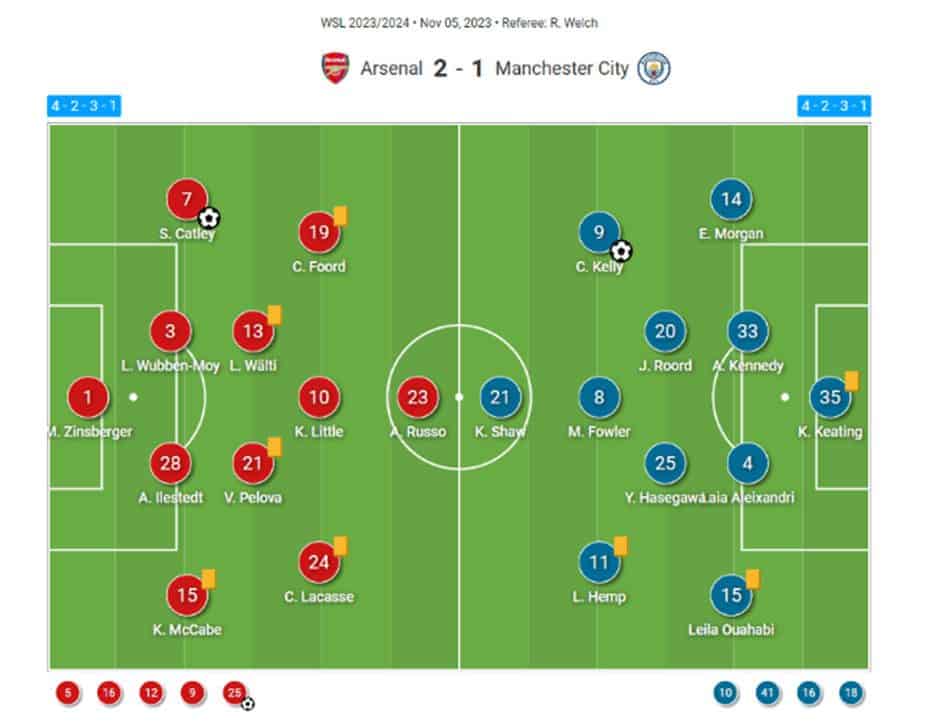
Coming into this game, Arsenal have changed their formation and lineups regularly. With Jonas Eidevall’s squad slowly returning to full fitness, he appears to be still searching for his best lineup and having started the season in a 1-3-4-3 shape with both Russo and Blackstenius starting in the front line together. Then Arsenal moved away from the 1-3-4-3 and opted for the 1-4-2-3-1 they deployed against Manchester City.
In this game, they opted for a midfield three of Pelova and Walti as the two deeper midfielders behind Kim Little playing as the ten behind the striker. They had previously started Maanum in the midfield. The major change in this game for Arsenal was Lacasse, who was put on the right wing, starting her first game since the opening game of the season against Liverpool. This meant the in-form Katie McCabe was moved back to right back for this game.
Manchester City also had some major changes to their usual lineup. However, the formation remained the same. Most notably, the club captain and central defender Alex Greenwood was ruled out with an injury. Greenwood was replaced by Laia Alexandria, who had played the previous three games at left-back for the suspended Leila Ouahabi. Ouahabi returned for this game. The next major change was the return of England international Lauren Hemp on the left wing, having missed the previous two games. This meant Mary Fowler was dropped back into the midfield, and Fillipa Angeldahl was dropped to the bench.
Arsenal defending deep
The first notable tactical idea was how Arsenal looked to defend against Manchester City’s patient possession dominant system, where they would look to stretch the entire width of the field and overload the wide channels by creating wide triangles with the wide midfielder, fullback and winger. They have been particularly dangerous from these wide areas due to the threat of wingers Chloe Kelly and Lauren Hemp in 1v1 situations and combined with the creative attributes of fullbacks but particularly the wide midfielders Mary Fowler and Jill Roord, whose movement off the ball, has enabled Kelly and Hemp to get those 1v1 matchups.
Now we have an idea as to how Manchester City want to play; we can look at how Arsenal was able to slow them down. The first thing they did to combat these wide channel overloads City tried to create was to match City up player for player, so if City wanted three players, Arsenal would have 3 to create a 3v3 and the same for 2v2. When they were in these situations, Arsenal were disciplined in tracking these runs, and the most notable thing was that if City were able to gain a yard on Arsenal, they would keep working to try and prevent balls into the box and force City to play and execute quality throughout the game. Which, in the end, they were unable to do.
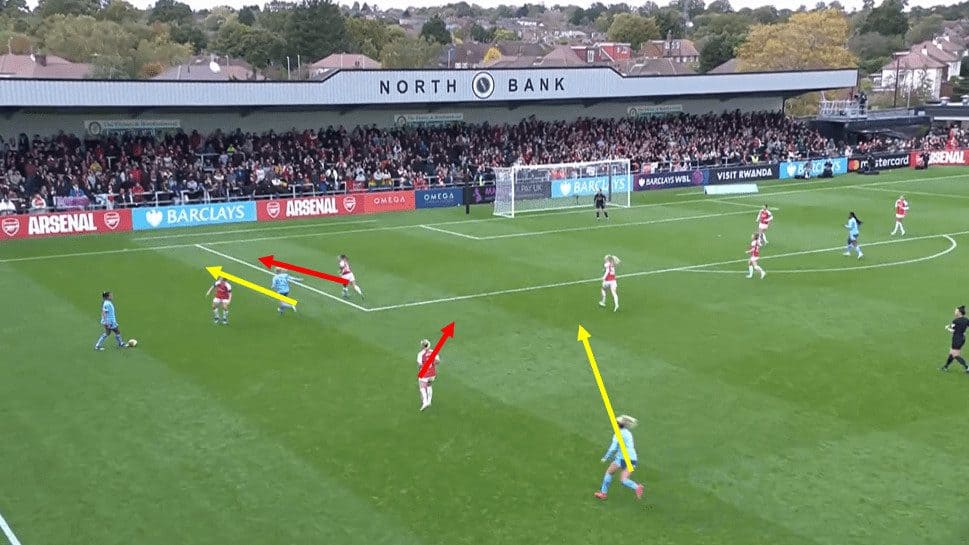
In the above situation, you can see how Arsenal can match up with Arsenal player for player to create a 3v3 situation. With Fowler on the ball, she is pressed and engaged by Kim Little. Then you have Hemp making a run from deep, which is blocked and tracked by winger Beth Mead. Then you have McCabe tracking the underlapping run by substitute left-back Julie Blakstad.
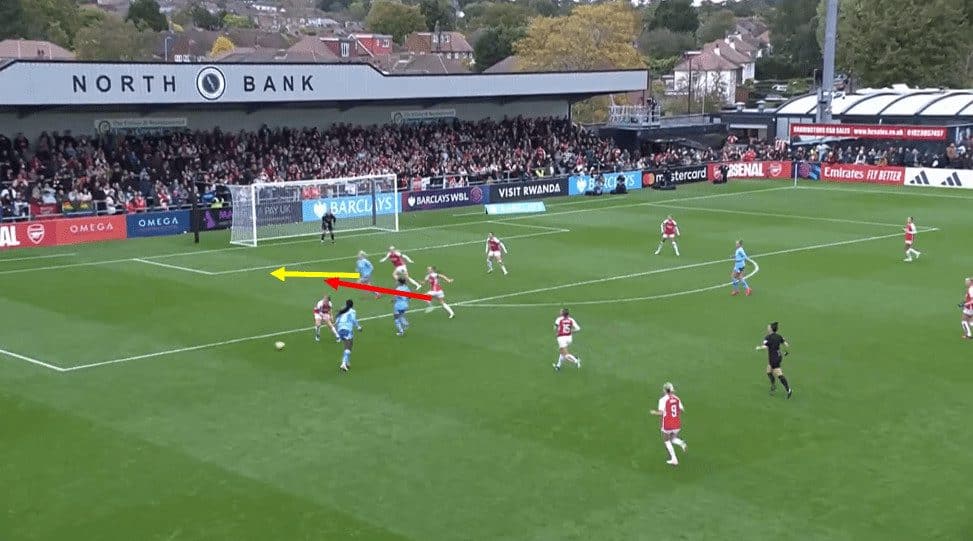

Above is a good example of how Arsenal forced City to play quality balls into the box. In the top picture, you can see how Hemp has made a run across the backline and managed to get some separation from the Arsenal backline.
However, you will also notice how midfielder Pelova has worked back to track this run, although she is unable to prevent Hemp from getting the ball. She can get out and put some pressure on the cross, which Hemp will feel and sense.
This results in a poor ball into the box, which Lotte Wubben-Moy clears away. Another thing to note is how many Arsenal players are in the box; there are seven against five City players now. Simply by looking at numbers, you would suggest that Arsenal should be able to clear away more balls than if they had even numbers, as they have two spare players.
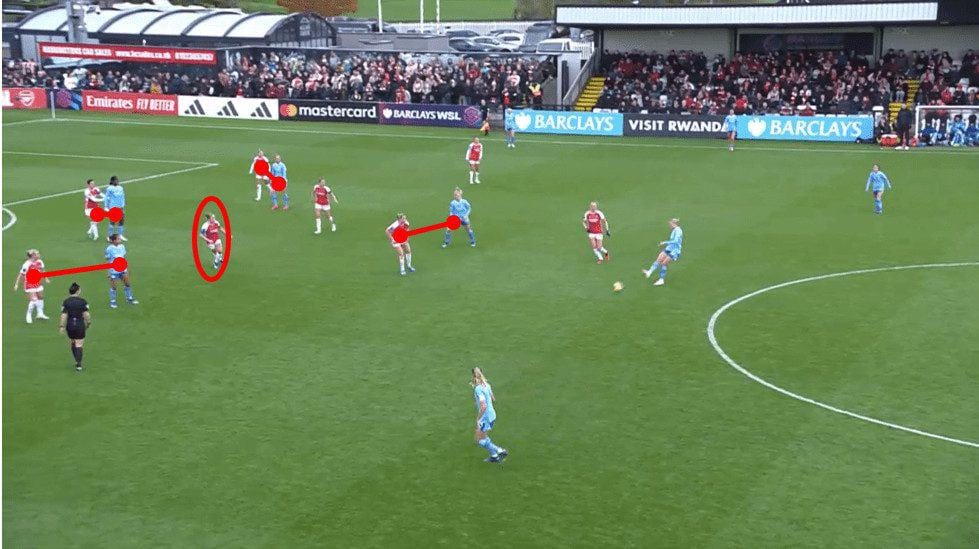
It’s also important to note how Arsenal condensed the middle areas of the field, which forced City to try and play around their shape and into these wide situations where they were confident in their game plan. You can see in the above image how condensed the midfield has become with any penetrating option to a midfielder or to striker Bunny Shaw being blocked off. All eleven Arsenal players are behind the ball, and all players either closely mark a City player or block a passing line. For example, Kim Little’s case, highlighted by the red circle, blocks the passing lane between the ball and striker Bunny Shaw.
Pressing the City build-up
The next important aspect of the game for Arsenal was how they looked to force mistakes out of the City backline, particularly during the build-up phase. The most notable way they achieved this was by removing the pivot of Hasegawa in midfield. Later when Ouahabi started to move centrally as an inverted fullback, passing lanes to her were equally blocked. They would then put the defensive line high up the field and challenge the hold-up ability of the City forwards of Hemp, Kelly and Shaw by forcing the defence and often goalkeeper Khiara Keating to play long.
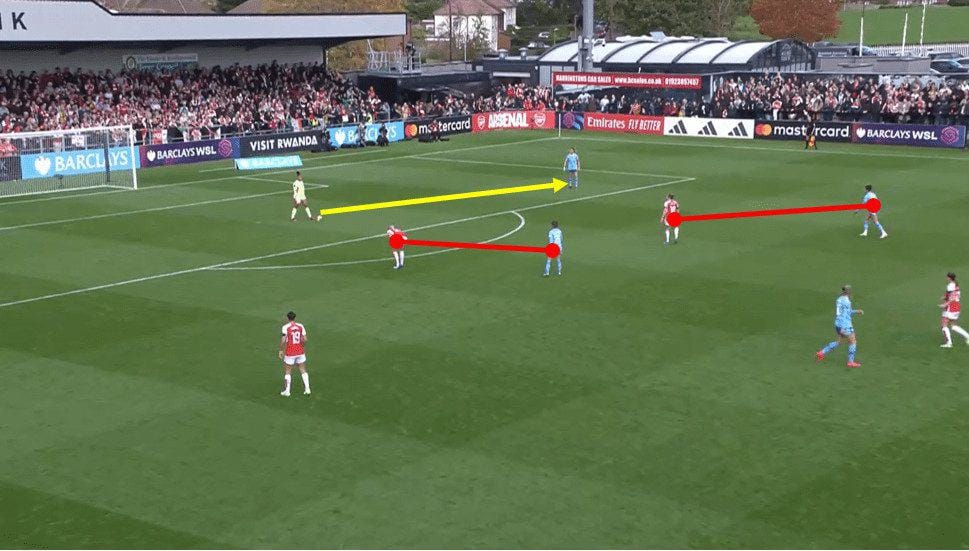
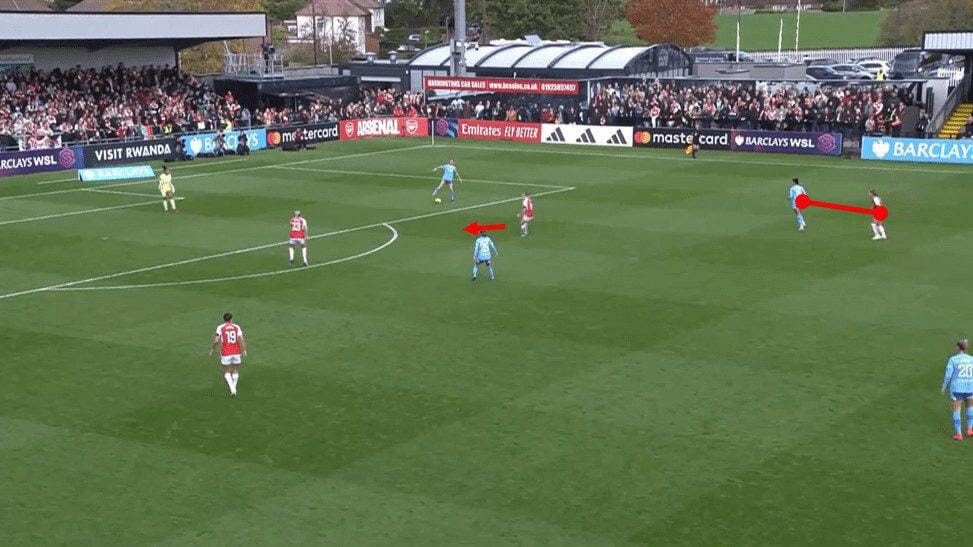
In the above example, you can see how the ball initially starts with goalkeeper Keating; in this case, the passing lane to Hasegawa is blocked by striker Alessio Russo. Then, as the ball moves across to left centre-back Aleixandri, Kim Little works across to block the passing lane to pivot Hasegawa.
Minor, in particular, was integral to this ability to block the pivot in the build-up as she was consistently able to position herself between the ball and the pivot player and be aware of how to reposition as passing angles changed throughout the game. I’d also like you to note how winger Chloe Lacasse is tracking Ouahabi as Ouahabi tries to play narrower and offer herself as an alternative pivot option.
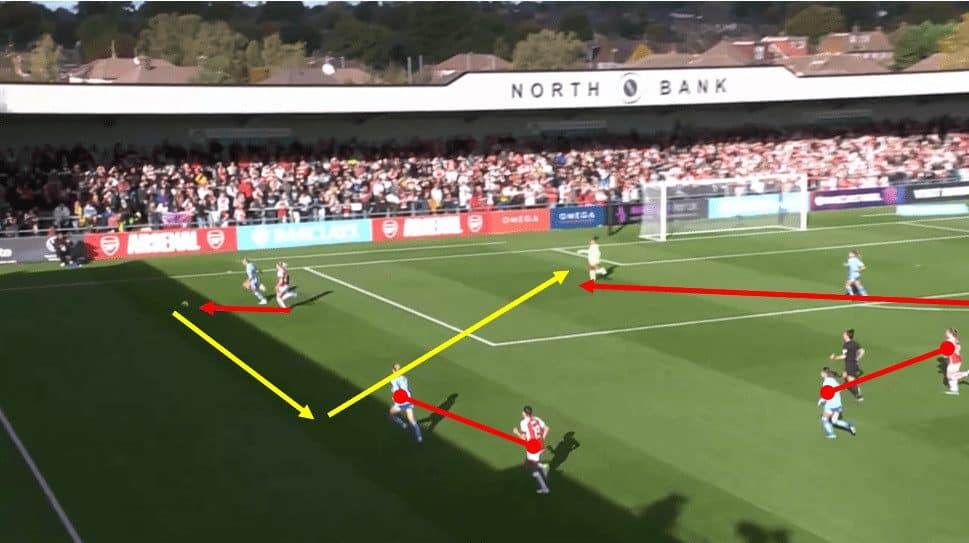
This play leads up to a penalty being awarded to Arsenal. You have a relatively simple long ball played forward by Steph Catley for Russo to run onto. However, centre-back Kennedy is put under relentless pressure by Russo. This forces her to play a ball into right-back Esme Morgan, but winger Caitlin Foord closely marks Morgan, and she is forced to play a pass back to the goalkeeper. But this ball under pressure was poor, and Lacasse was able to draw a foul from Keating and win a penalty.
Hitting City on the break
So now we have dissected how Arsenal were able to reduce the threat of City in attack. Let’s look at how Arsenal were able to bide their time and wait for the perfect opportunity to attack and punish the City defence.
They tried to score from quick transitions, trying to catch the City defence out of shape as when City were able to get bodies behind the ball, they were able to nullify the Arsenal attack and get bodies behind the ball and win the ball back off Arsenal with relative ease. So instead, Arsenal tried to catch them in situations when, for example, most City players were still in advanced positions coming out of attack-defence transition, where they play a high line possession. Another area they looked to catch City off guard was by taking set pieces quickly and taking advantage of the disorganisation.
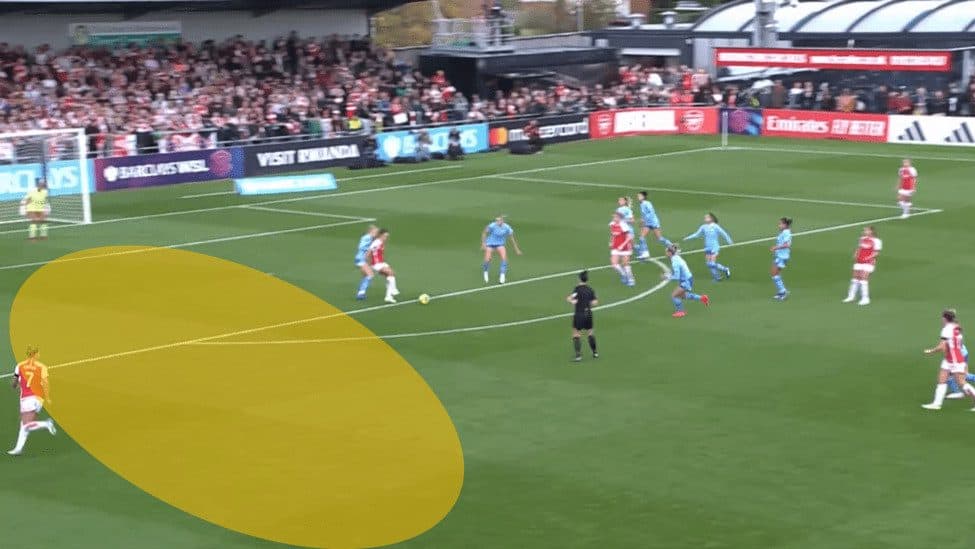
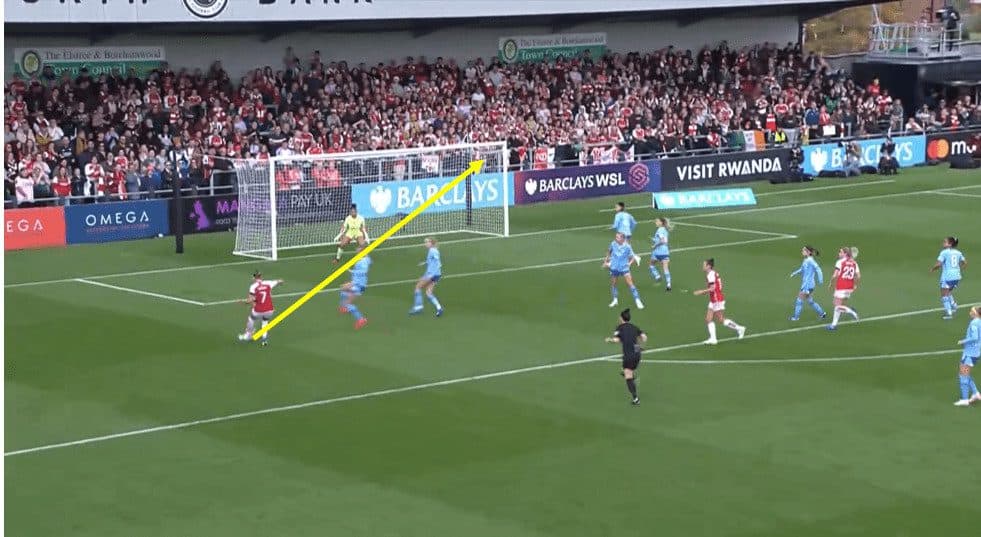
The above scenario leads to the opening goal of the game. To provide some context, Arsenal have just won a freekick around halfway. Arsenal take this freekick quickly and note how narrow the entire City team is, with all this space available on the left flank for Catley to run onto. Foord does well to hold off the backside pressure of defender Esme Morgan and play Catley through on goal, which she can finish well. By not allowing City to reset, they could take advantage of a disorganised City defence and take the lead in the game.
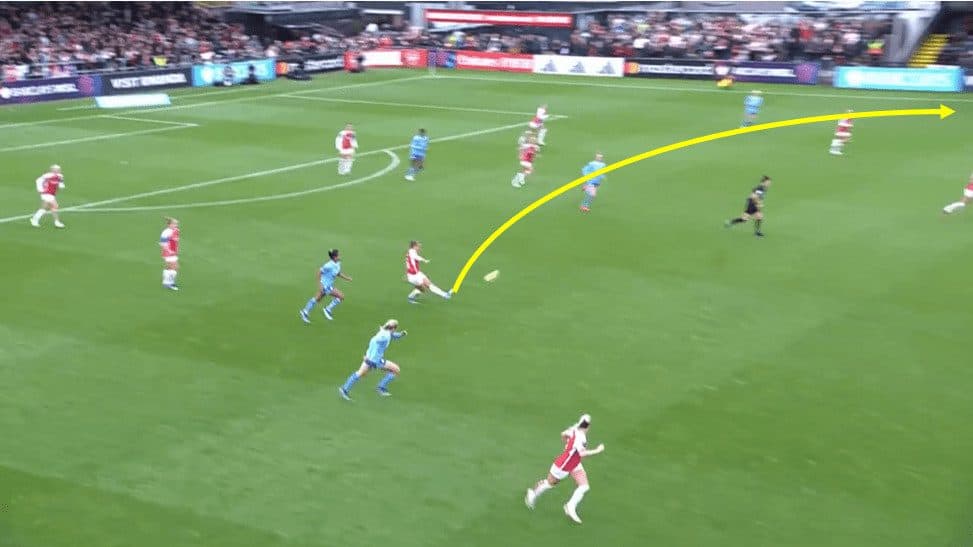
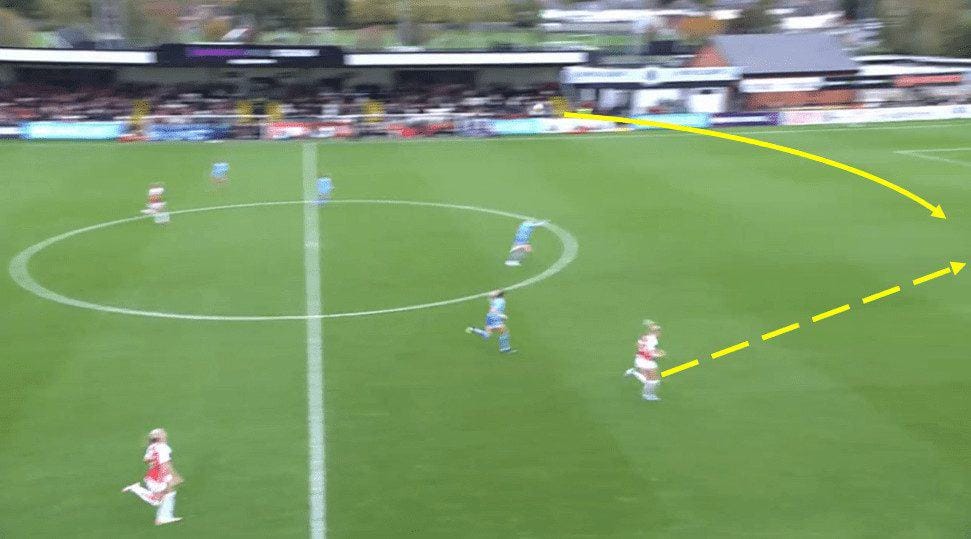
In this above example, Arsenal have won the ball deep in their own half following some City possession. All that’s going to happen is McCabe launches a ball over the top of the City defence for the speedy substitute Blackstenius to run onto. She can get in behind the City defenders, beating them for pace. Then Keating comes off her line and misjudges the bounce of the ball and is unable to clear it, and Blackstenius has an open goal in front of which she can finish off and score the winner for Arsenal.
Conclusion
As you can see, Arsenal had a clear game plan as to how they wanted to prevent a red-hot Manchester City side and, although not perfect, showed some positive signs as to what they can become throughout the season—earning themselves what could be a key win in the title race this season.
The most impressive aspect to note was how hard Arsenal worked even when they were out of position. For example, they knew that Bunny Shaw was going to try and get in behind the defence and try to pull CBs out of position. Their solution was to be disciplined in tracking Shaw’s runs and have defenders comfortable filling in and covering for each in a real team performance.
City, on the other hand, will be frustrated as they were able to create several chances and get into some perilous positions; however, they were unable to convert many of these positions and chances into goals, which would disappoint them, particularly how the two goals were conceded from lapses in concentration.





Comments